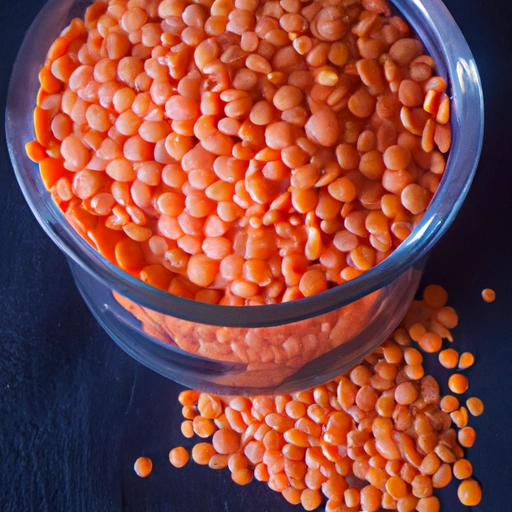Red Lentil
Description

Red lentils, known scientifically as Lens culinaris, are small, disk-shaped legumes that have a reddish-orange color when raw, which turns golden when cooked. They are prized for their quick-cooking nature and high nutritional value, making them a popular choice in kitchens across the globe. Red lentils are sold whole or split and are a common ingredient in many cuisines, particularly in South Asian, Middle Eastern, and Mediterranean dishes.
Common uses
Red lentils are commonly used as a thickening agent in soups, stews, and purees. They are also the base for traditional dishes like Indian dal, Middle Eastern mujadara, and Turkish lentil soup. Additionally, red lentils are increasingly being used in the production of gluten-free pasta and baked goods due to their high protein content and binding properties.
Nutritional value
Calories
A standard serving size of 1/4 cup (50 grams) of raw red lentils provides approximately 180 calories (753 kJ).
Protein
Red lentils are a rich source of plant-based protein, offering about 13 grams per 1/4 cup (50 grams) of raw lentils.
Fat
Red lentils are naturally low in fat, with less than 1 gram per 1/4 cup (50 grams) of raw lentils.
Carbohydrates
Red lentils contain about 30 grams of carbohydrates per 1/4 cup (50 grams) of raw lentils, including a significant amount of dietary fiber.
Vitamins
They are a good source of B vitamins, particularly folate and thiamine, which are essential for energy metabolism and nervous system function.
Minerals
Red lentils are high in minerals such as iron, magnesium, phosphorus, and potassium, contributing to various bodily functions including oxygen transport and muscle contraction.
Health benefits
Red lentils are known for their health benefits, including promoting digestive health due to their high fiber content, aiding in weight management, supporting heart health by potentially lowering cholesterol levels, and providing a substantial amount of plant-based protein and essential amino acids for muscle growth and repair.
Potential risks
Although red lentils are generally considered safe for consumption, they do contain antinutrients like phytic acid, which can reduce the absorption of certain minerals. Moreover, people with legume allergies should avoid red lentils. It is also advisable to rinse and cook red lentils thoroughly to reduce any potential risk of consuming lectins, which can cause digestive discomfort when consumed in large amounts.
Common recipes
Red lentils are a key ingredient in many recipes such as Indian dals, soups, stews, curries, and salads. They can also be found in vegetarian burgers, lentil spreads, and as a meat alternative in various dishes.
Cooking methods
Red lentils can be boiled, simmered, or pressure-cooked. Unlike other lentil varieties, red lentils cook relatively quickly, in about 15 to 30 minutes, and do not require pre-soaking. They tend to break down and become creamy, making them ideal for thickening dishes.
Pairing with other ingredients
Red lentils pair well with a variety of flavors and ingredients such as cumin, coriander, turmeric, garlic, onions, tomatoes, coconut milk, and an assortment of vegetables. They also complement rice, quinoa, and bread.
Summary
Red lentils are a versatile, nutritious, and easily digestible food ingredient. Their global popularity is due to their rich flavor, ease of cooking, and ability to absorb the tastes of spices and other ingredients with which they are cooked. Red lentils are not only a vital component of vegetarian and vegan diets but also a staple in meat-eating households, contributing to a balanced and healthy diet for people all around the world.